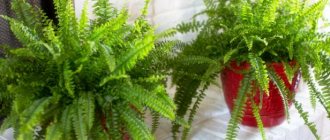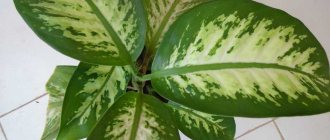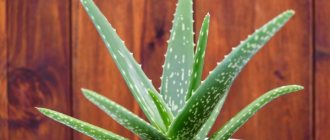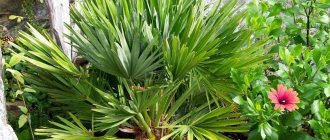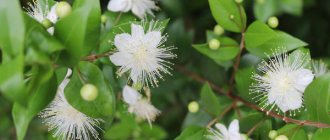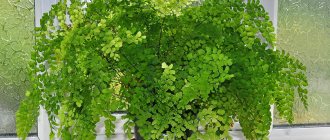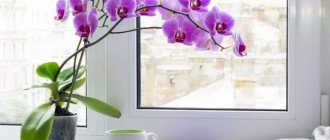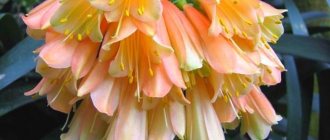- August 16, 2019
- Houseplants
- Ksenia Stepanishcheva
Fern is great for landscaping apartments and houses with insufficient lighting. This plant is considered shade-tolerant, so it can be placed on north-facing windows, in bathrooms, kitchens, and hallways. It also feels comfortable at high temperatures and humidity. How to care for ferns at home is described in the article.
Structure and reproduction
The main structural feature of the fern is the absence of seeds and the ability to reproduce by spores.
Stems can be curly and erect, branched and straight. Their length ranges from a few to 25 centimeters. The leaves (fronds) also vary in length - from 3-4 cm to 30 meters.
The fern reproduces by spores (at home this method is problematic) and by dividing the bush.
Manifold
There are several types of indoor ferns that take root well at home:
- Maidenhair. This plant has thin, strong stems and graceful fronds. It prefers warmth, shade and moisture. It is advisable to grow this species in winter gardens and terrariums. Names: Radi, Delicate, Fine-haired, Venus hair.
- Asplenium. This type of indoor fern likes to be in the shade and in moist air. At home, several species are bred that are not similar to each other. These are Nesting and Bulbous, Viviparous.
- Nephrolepis. The plant needs space. The fronds are dissected, which ensures an original openwork effect. Nephrolepis sublime is commonly grown and is very easy to care for. Reproduction is carried out by dividing a large bush or by shoots.
- Blekhnum. The crown is 1 meter in diameter, and the rigid fronds are similar to a palm tree. Commonly grown blechnum humpback and brazilian.
- Davallia. The plant has thick rhizomes. That's why it is called hare's or squirrel's feet.
- Platycerium. The fern has large, showy leaves, like the antlers of a deer.
- Disconia. A mature plant can be 3 meters tall, so it is suitable for spacious rooms.
- Pelley. The plant prefers dry habitats. Pellea Roundifolia and Green are in demand.
- Polypodium. The leaves of the plant are heavily dissected.
Large plants look original in hanging pots and stands. Their feathery leaves are used to decorate bouquets. Torn fronds are quickly restored.
What to do after purchase?
As soon as the fern is brought into the house, it should be isolated from other crops.
After a two-week quarantine, the plant is replanted. The container and soil must be new. It is advisable to choose a clay or ceramic pot. It is better to purchase ready-made substrate for ferns. A drainage layer, for example, made of brick chips, must be placed at the bottom of the pot.
Transfer
An adult fern should be replanted every 3 years. Young plants require annual changes of the substrate, or rather the pot, because... The fern roots grow and need more space.
Everything is extremely simple: after winter dormancy (usually in March), the plant is removed from the old soil. The soil is carefully cleared from the roots, and the plant is transplanted into a new container, where at the bottom there is a layer of expanded clay drainage, and coniferous soil is mixed with peat as a substrate. A little leaf humus won't hurt.
After replanting, you need to slightly refresh the leaves from the sprayer and put them in their place.
Photo 3. Fern spores
Pot
It is better to choose a ceramic or clay container for planting ferns. The material should easily absorb and release moisture.
For the first three years of crop development, it is recommended to change the flowerpot every year (preferably in the spring). Then one transplant every three years is enough. The volume of the container depends on the root system.
The diameter of the pot is selected several centimeters larger than the diameter of the rhizome.
Capacity
You need shallow, wide flower pots. Medium ones are fine to start with, but it is important that they are the right size for the root system. In a container that is too large, the plant often gets sick, and in a small container it stops developing.
As they grow, they will need to be transplanted into larger flower pots. It is important that the container is round, without curved edges, since during transplantation it will be easier to transfer the soil tuber.
To grow flowers, experts recommend using clay pots, which allow the roots to “breathe” and do not release components that are toxic to humans. You should not worry about external unaesthetics; the container will be covered with thick foliage. Clay pots are massive and stable, so they can hold a flower. Their disadvantage is that microbes and pathogenic fungi can enter the root system with air.
What to feed for growth and what does it like?
Fertilizing is an optional procedure when growing ferns; the plant can easily live without it. But if the leaves become pale, limp or stop growing altogether, it is worth adding fertilizer, since this state of the flower is a sure sign of a lack of nutrients.
The best time to apply fertilizer is during the period of active growth (late spring-early summer). It is recommended to choose liquid fertilizers, as they are better absorbed by the soil. You can choose ready-made complexes for ferns.
Trimming
Each part of the plant is very important in the life of the entire plant, so pruning the fern should only be done in emergency cases if:
- parts of the plant are injured or damaged (for example, by sunlight or cold air);
- the plant is damaged by insects or disease;
- there is a need to stimulate the growth of fresh foliage.
If pruning still needs to be done, it is better to do it not at the peak of growth. For an indoor fern, 1-2 trimmings per year is sufficient. Old leaves that have turned yellow from time and age of the flower should be cut with pruning shears or garden shears. There is no need to trim tendrils or parts of roots that hang down. If you want to make them invisible, you can twist them and “hide” them in a pot, above the soil, securing them with wire.
Please note! The best option for propagating a flower at home is to plant a large plant. Reproduction by spores is an extremely complex process.
Do-it-yourself fertilizer for garden and other varieties
Or you can cook it yourself. A liter of solution must contain the following components:
- potassium salt (1 g);
- superphosphate (1.5 g);
- ammonium nitrate (1.5 g).
Use organic fertilizers with caution as they can burn the roots.
Therefore, it is better for novice gardeners to completely abandon the use of fertilizing. It is better to water the flower with weak tea leaves once every two weeks.
Features of seasonal care
Fern care has some differences in different seasons. Although the plant does not have a clearly defined dormancy.
In spring and summer it is necessary to ensure:
- temperature +20-25 degrees;
- regular moderate watering;
- feeding 1-2 times a month;
- bright diffused light.
In winter, all processes are dulled, so the plant can be slightly lowered in temperature, reduce the amount of watering, and stop feeding.
How often to water?
The main thing in this matter is moderation. Fern is a moisture-loving plant, but it does not tolerate waterlogged soil. The gardener's task is to constantly maintain the substrate moist. As soon as the top layer of soil has dried, you can moisten it again.
If the soil is too dry, then subsequent moistening does not always save the plant. The optimal frequency of watering is once every seven days. Moisturizing should be plentiful. It is recommended to use settled or rain water for irrigation.
Watering
The plant loves water. Prolonged drought destroys it. How often should you water your fern? The procedures should be performed after the top of the soil has dried.
But excess moisture also negatively affects the root system and can lead to the death of the plant. If there is too much moisture, yellow and brown spots will appear on the leaves, the roots will rot, and the plant will dry out. Watering should be done several times a week with settled water at room temperature.
Special requirements in winter
In winter, ferns need special care. First you need to provide additional lighting. It is better to use special phytolamps or any others that do not heat up for this.
In winter, the indoor air is usually dry, so the plant needs to be sprayed generously.
It would be good if there was a humidifier in the room. If it is not available, it is enough to place a container of water next to the flowerpot.
The frequency of watering depends on the drying time of the soil. In winter, it should also not be allowed to dry out completely.
Indoor fern - environmental inspector
Indoor ferns , like their wild relatives, are considered unpretentious plants. But, nevertheless, not in all conditions they will grow well and look attractive. In the forest, ferns thrive on sandy and especially peat soils. Moreover, without daily watering, in the heat, without replanting or pruning. But in an urban environment, even in good soil they can wither away. Why? Because ferns are a kind of indicator of the purity of the atmosphere.
Ferns do not tolerate gas pollution and smoke in the atmosphere very well, they react to dry air, and if you decide to have an indoor Fern at home, then first of all provide it with access to fresh air. But on the other hand, if you bought this flower, and at home it began to wither, this is a reason to wonder if everything is in order in your apartment. Maybe there's a gas leak somewhere or it's time to install a hood in the kitchen. In addition, the indoor fern may dry out due to low air humidity - this is a hint to you that it is time to buy a humidifier or at least place a couple of vessels with water in the house for evaporation.
- How to grow an indoor flower from seeds
Diseases and pests
The main reasons for the development of diseases and pests on ferns are the following:
- errors in care (incorrect watering regime, drafts or poor-quality soil);
- infection of a fern from another crop.
Most often, plant diseases are caused by improper watering - cold water with a high chlorine content, or failure to maintain soil moisture.
The most common pests of ferns are nematodes. Due to their vital activity, the foliage turns yellow and dries, and then falls off.
To save the crop from nematodes, it needs to be transplanted into a new substrate and container.
Dry air leads to the appearance of scale insects, aphids and thrips. As a preventative measure, you need to spray the flower regularly. Various types of rot appear as a result of the development of pathogenic microflora, which is caused by waterlogged soil.
Soil preparation
The soil for indoor ferns should be loose, allowing air and water to pass through. Stagnant moisture causes root rot. It is desirable that the soil contains a lot of rotted leaves and a little less pine needles and peat.
Ferns need soil with slightly increased acidity (pH is 5.0-6.6). The parameter is easily established using litmus paper. Soil (2 g) must be mixed with distilled water (10 ml). Shake the mixture and let it sit for a while. Then you need to lower litmus paper into the liquid above the sediment. At pH = 5 it will be yellow, and at 6 it will be greenish-yellow.
Useful video
The video gives the main tips for caring for the plant in an accessible language:
Fern is a plant with a long history. This popularity among gardeners is explained by its unpretentiousness and variety of species. For active growth of the crop, you need to adhere to the minimum rules of care.
Find out more information about the types of ferns: adiantum, asplenium, blechnum, davallia, nephrolepis, pellea, platicerium, phlebodium, cirtomium.
Is it poisonous or not?
Any of the types of fern grown at home is not considered deadly poisonous. But most of them cannot be eaten; you can get food poisoning. This means that people who have small children and pets in their home should place these plants in hard-to-reach places.
Fern spores can cause an allergy attack.
There are several folk recipes where the main ingredient is heat-treated fern. The effectiveness of such drugs has not been proven, so it is better to consult a doctor before using them orally.
Looking after a plant at home
By taking care of house ferns, they create a climate very similar to the natural one. This is required:
- ambient temperature;
- moisture in the surrounding environment;
- presence of light;
- frequency and size of humidification;
- availability of fertilizers;
- transplantation.
The bulk of bred ferns, as in the photo, are immigrants from hot places or subtropical areas of the planet. Although there are also original inhabitants of zones with mild conditions. They must be protected from wind, sudden changes in temperature, and hot sun.
